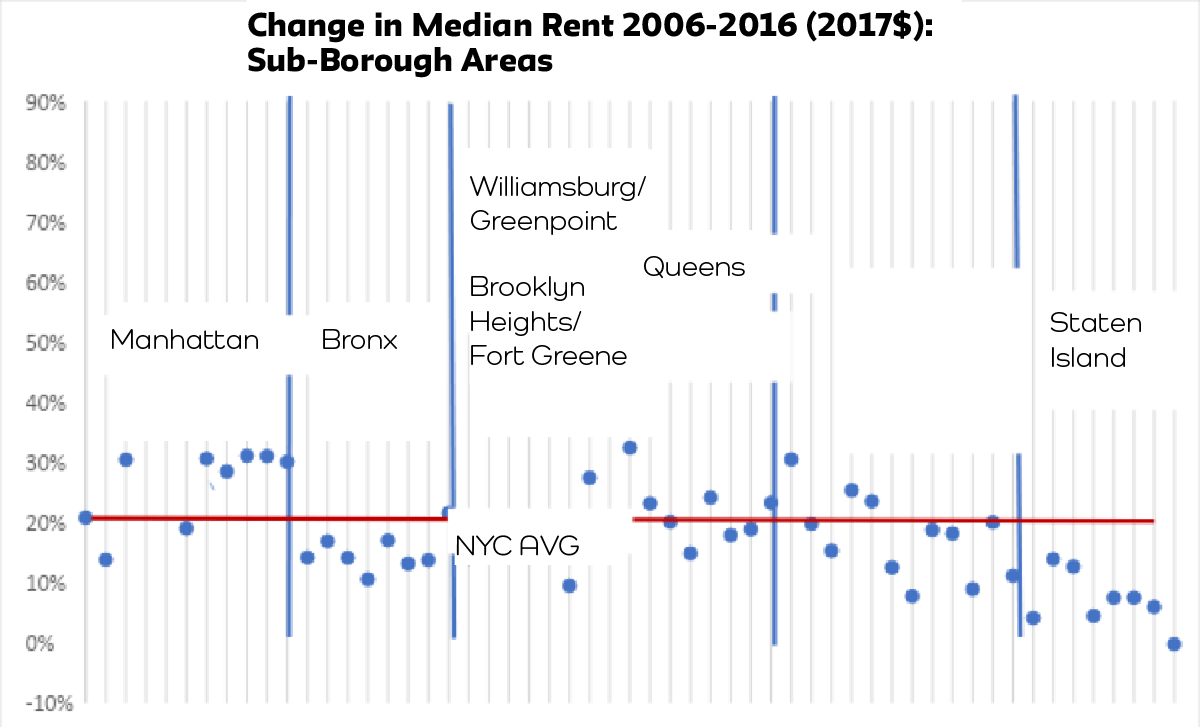February 19, 2020
Are de Blasio’s Rezonings a Trojan Horse for Gentrification? Probably Not.
By Alex Schwartz
Mayor Bill de Blasio’s “Housing New York” plan currently projects building or preserving 300,000 affordable housing units by 2026 – 120,000 through new construction and 180,000 through preservation. The aspect of this plan that has received the most attention (and criticism) is its embrace of mandatory inclusionary zoning – a policy that some opponents have come to see as a kind of Trojan Horse for the forces of neighborhood gentrification.
Mandatory inclusionary zoning applies to neighborhoods that are rezoned for higher densities and also to individual sites granted higher-density zoning variances. It offers developers several options, all of which specify minimum percentages of units that must be provided to households earning various percentages of what is known as “area median income” (currently about $91,000 annually for a family of three). All affordable units produced under the City’s mandatory inclusionary housing program must remain affordable in perpetuity. As of July 2019, six neighborhoods, starting with East New York, have been rezoned at higher densities, thereby effectuating mandatory inclusionary housing; rezoning proposals also were in process or anticipated for at least three additional neighborhoods.
Critics, including other elected officials, academics, journalists, and community activists, argue that these rezonings have the perverse effect of exacerbating housing affordability problems, even if the new housing built in rezoned neighborhoods includes affordable units. They contend that it not only fails to provide sufficient amounts of housing affordable to low-income residents; by rezoning low-income neighborhoods to promote development of large mixed-income buildings, the plan puts increased market pressure on vulnerable communities.
The resulting influx of higher-income households combined with the tangible changes in neighborhood fabric as low-rise and vacant properties – residential and otherwise – are replaced by much larger, glitzier residential and mixed-use buildings will tempt owners of existing residential buildings to raise their rents. If that’s not possible under the City’s rent regulations, they may resort to attempts to push current tenants out. The argument is thus that while the buildings put in place under inclusionary zoning will include a number of units of affordable housing (notwithstanding arguments about their actual affordability), the net effect of the rezoning process may ultimately be a loss of affordable housing.
Mayor de Blasio and other City officials have responded to this argument in two ways. First, they point out that the City has strengthened its protections for tenants who might face illegal rent increases, harassment, and eviction by, for example, rolling out free legal counsel in Housing Court for low-income renters. The City and State have also created a task force to combat landlord harassment. Through these and other means, the City believes that it can shield existing residents in rezoned neighborhoods from unlawful rent hikes and various forms of harassment. Second, they also point out that gentrification is occurring throughout the city, whether or not the neighborhood has been rezoned.
Rezonings require public review, community input, and approval by the City Planning Commission and City Council. That process has provided arenas for a full and forceful presentation of oppositional arguments. The fact that the residents of the neighborhoods slated for rezoning tend to have low incomes and to be predominantly non-White has also no doubt contributed to the plan’s often-hostile reception. (The plan might well have received more support if the City had also included more affluent and more White neighborhoods among those to be rezoned.)
But does that make the critics right? On balance, the evidence just isn’t there.
Although there are few if any studies that show the effect of rezonings in New York City during the de Blasio era on rents and home prices, it is true that rents have increased sharply in numerous neighborhoods through the city. Adjusting for inflation, the median rent in the city as a whole increased by 20 percent from 2006 through 2016. In Manhattan, rents rose by 29 percent; Brooklyn, 25 percent. Of the city’s 55 sub-borough areas (roughly similar to its community districts), 26 saw rents rise by 20 percent or more, including 13 where they increased by at least 30 percent. There seems to be ample justification for the claim that preserving the existing zoning of a neighborhood will not keep gentrification at bay.
Source: CoreData.NYC
Also, despite the enmity mandatory inclusionary zoning has inspired in some quarters, it’s worth keeping in mind that this component accounts for a relatively small share of the affordable housing produced to date. Mandatory inclusionary housing accounted for only 1,431 housing units starts as of March 31, 2019. That’s less than four percent of all City-funded new construction starts to that date. Moreover, most if not all of the new housing subject to inclusionary zoning in East New York – the first neighborhood to be rezoned – has been targeted to low- and moderate-income households. Most of the new construction started under the plan has received direct subsidies from the City and other sources.



